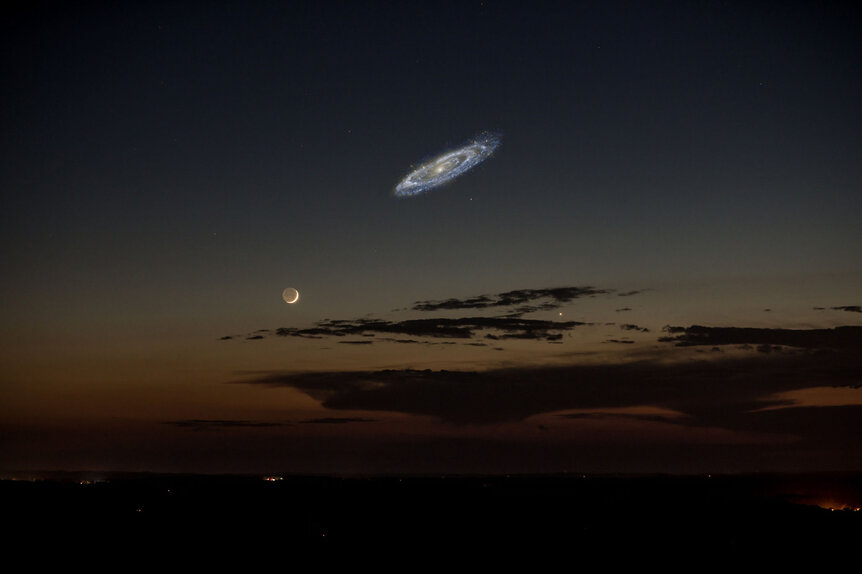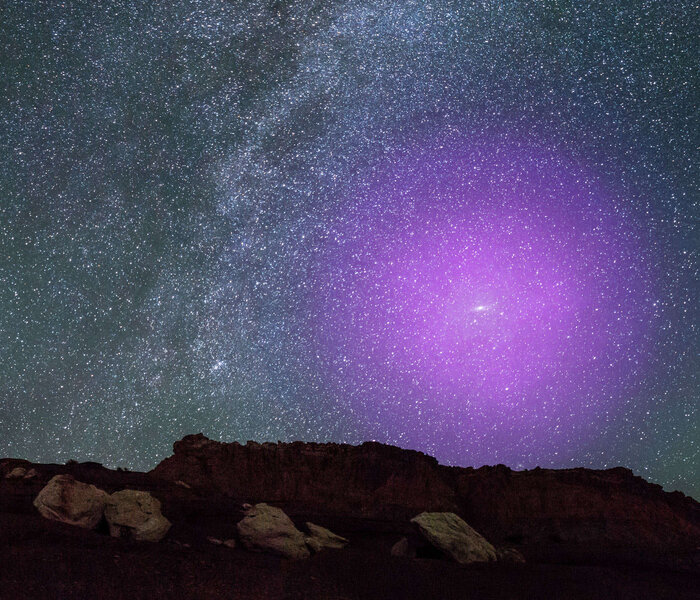Create a free profile to get unlimited access to exclusive videos, sweepstakes, and more!
The Andromeda galaxy's halo is already colliding with the Milky Way's

Weirdly, the biggest part of a galaxy is the hardest thing to see in it.
Or, more accurately, around it. I'm talking about a galaxy's halo, the huge spherical volume surrounding a galaxy, typically made up mostly of gas (there are some stars in it but not many… and there's also a dark matter halo, but we'll skip that for this discussion).
When you think “spiral galaxy” you probably picture a disk of gas and stars, maybe with a bulge of stars in the middle. That's fine, but the halo is so huge it positively dwarfs that inner part. A disk might be 100,000 light years across, but the halo can be ten times that. More.
It's so faint it's hard to see, though. Even nearby galaxies have halos so faint you can't really see them directly. However, astronomers are clever, and have found ways to measure them indirectly. Using such a technique, aided by observations with Hubble Space Telescope, new research shows that the nearby Andromeda galaxy has a layered halo, two nested spherical shells, with the outer one reaching out to a staggering two million light years.
Our own Milky Way has a halo, too, and it reaches out to about one million light years. We know that the Milky Way and Andromeda are heading toward each other and will collide in about 4.6 billion years. But…. Andromeda is about 2.5 million light years away. That means that the halos of these two galaxies are already colliding!
That's pretty neat, though maybe also a little discomforting.
Not that we'd really notice; the haloes that far out are so tenuous that them overlapping probably doesn't mean much; they'd hardly notice the other was there. Still, it's cool to think that the collision process has, in some way, already begun.
The extent of the halo isn't what the astronomers really were going for, though. They were more curious to find out what's in it, and its structure.
Since Andromeda's halo is so faint, they couldn't see any light it emitted directly. Instead, they did the opposite: They looked for light sources behind it, in this case quasars, active galaxies billions of light years away that are blasting out light. As the light from the quasars passes through the halo, elements like oxygen and silicon in the halo absorb very specific wavelengths of light (think of that like colors), revealing their presence.
They looked in the ultraviolet (UV), because the gas in the halo is hot, and hot atoms are good at absorbing UV. They used the Cosmic Origins Spectrograph on Hubble, which is designed specifically to look at UV colors, so was perfect for this work.
The fun thing here is that Andromeda is so close and its halo so huge that it covers a big swath of sky. The inner part of the halo is over 20° across! That's a lot of sky, which in turn means there are lots of quasars in the distant Universe that happen to be behind it. This allowed the astronomers to probe a lot of different spots in Andromeda's halo — they used observations from Hubble and other telescopes to look at 43 quasars in total — something that can't be done for any other galaxy on the sky.
They found a couple of interesting things. One is that the halo is layered. The inner halo stretches out to about 500,000 light years, and is fairly complex. The outer halo goes from there out to 2 million light years, is smoother, and hotter.
The inner halo is rich in heavy elements like carbon, silicon, and oxygen. Those are made in massive stars, which then expel them by strong winds (like the Sun's solar wind but much more powerful) or by exploding as supernovae. So those elements are coming from stars in Andromeda's disk, which is then blasting them out into the halo. The bulk of this material was probably blown out billions of years ago; Andromeda isn't churning out stars very much right now. It made most of its stars less than six billion years after it first formed, and had a second, minor peak in star birth about two billion years ago. Massive stars don't live long, so it's likely those elements were blown out into the halo a long, long time ago (in a galaxy relative near away).
From their measurements (combined with previous ones from other astronomers) they can estimate the total amount of those heavy elements that are in the halo: About 250 million times the mass of the Sun. Oof. That's a lot. In fact, the entire disk of the galaxy, where all the stars are, only has about twice that mass in heavy elements. That surprised me. The halo is tenuous, so it having that much stuff in it is interesting.
Andromeda is one of the few galaxies that can be seen by the naked eye without optical aid like binoculars (though it looks better that way, of course). By eye it looks like a smudge in the sky, but the true extent of the disk is many degrees, far larger than the full Moon in the sky. The halo, though, is much, much larger, about the width of the Big Dipper!
Mind you, the outer halo is so big it stretches nearly from horizon to horizon. That's a bit overwhelming. Andromeda is millions of light years away! To think that part of it occupies most of our sky is phenomenal.
Andromeda is up in the fall for northern hemisphere viewers, and in fact is up even in late summer (now) before midnight. If you happen to be out in a dark site on a moonless night, give it a look. It's one of the most distant objects you can spot with your eye… and, we now know, apparently one of the biggest.





























